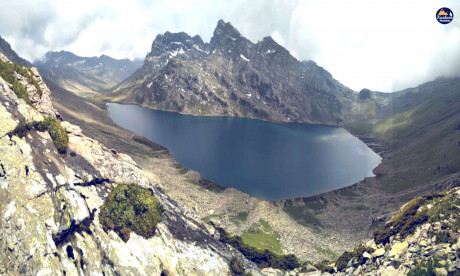The mighty Himalayas, often referred to as the “Abode of Snow,” boast some of the world’s most impressive glaciers. These colossal masses of ice play a crucial role in shaping the region’s landscape and have a significant impact on the lives of millions of people living in the Himalayan foothills. In this article, we embark on a journey to unravel the mysteries of Himalayan glaciers, exploring their importance, challenges, and the unique features that make them majestic giants.
The pristine region of Kashmir is adorned with a crown of majestic mountains, among which lie glaciers that silently carve the landscape over millennia. In this article, we delve into the glacial wonders of Kashmir, exploring their significance, unique features, and the delicate balance they maintain in the region.
The Glacial Tapestry:
Sheeshnag Glacier:
Located in the Lidder Valley, the Sheeshnag Glacier is a mesmerizing expanse of ice surrounded by towering peaks. It is a crucial source of water for the Lidder River, sustaining the lush meadows and forests downstream.
Kolahoi Glacier:
Resting beneath the mighty Kolahoi Peak, this glacier is one of the largest in the Kashmir Valley. Its meltwater feeds the Lidder River and contributes to the flourishing biodiversity in the region.
Thajiwas Glacier:
Tucked away near the popular tourist destination of Sonamarg, Thajiwas Glacier is easily accessible and offers a glimpse into the glacial landscapes. Visitors can trek to witness the icy spectacle against a backdrop of lush meadows.
Significance of Kashmiri Glaciers:
Water Source: The glacial meltwater from Kashmir’s glaciers feeds several rivers, including the Jhelum and Chenab, which are lifelines for the region’s agricultural activities and support local communities.
Tourism and Recreation: The stunning glacial landscapes attract adventure enthusiasts and nature lovers. Treks to glacier snouts, such as those in Sonamarg and Pahalgam, provide an immersive experience of Kashmir’s natural beauty.
Hydropower Generation: The cascading rivers fed by glacial melt contribute to the generation of hydropower. Numerous hydroelectric projects harness the energy derived from these glacial waters.
Importance of Himalayan Glaciers:
Water Source: Himalayan glaciers act as a vital water source for numerous rivers and tributaries, providing freshwater to millions of people downstream. Major rivers like the Ganges, Indus, Brahmaputra, and their tributaries originate from these glaciers.
Climate Regulation: The glaciers in the Himalayas play a crucial role in regulating the region’s climate. They act as a natural thermostat, influencing weather patterns and maintaining ecological balance.
Biodiversity: The unique ecosystems around Himalayan glaciers are home to diverse flora and fauna. Many species, including rare and endangered ones, depend on the glacial ecosystems for their habitat.
Cultural Significance: Glaciers hold immense cultural and spiritual significance for the local communities. They are often revered as sacred entities, and their meltwater is considered holy.
Challenges Facing Himalayan Glaciers:
Climate Change: Rising temperatures due to climate change pose a severe threat to Himalayan glaciers. Increased melting rates and altered precipitation patterns impact the glaciers’ mass balance, leading to concerns about their long-term survival.
Glacial Lake Outburst Floods (GLOFs): The retreat of glaciers has resulted in the formation of glacial lakes. The sudden release of water from these lakes, known as Glacial Lake Outburst Floods, can have devastating effects on downstream communities.
Water Scarcity: While glaciers contribute significantly to freshwater resources, their depletion can lead to water scarcity in the long run, affecting agriculture, hydropower generation, and daily livelihoods.
Infrastructure Development: Human activities, including infrastructure development and tourism, can accelerate glacier retreat. Unplanned construction and increased foot traffic contribute to the degradation of glacial environments.
Unique Features of Himalayan Glaciers:
Siachen Glacier: Known as the world’s highest battleground, the Siachen Glacier is a testament to the challenging conditions in which glaciers exist. Located in the eastern Karakoram range, it is heavily militarized due to territorial disputes.
Gangotri Glacier: Regarded as one of the primary sources of the Ganges River, the Gangotri Glacier is a pilgrimage site for Hindus. Pilgrims trek to the Gaumukh, the glacier’s snout, to witness the origin of the sacred river.
Pindari Glacier: Nestled in the Kumaon Himalayas, the Pindari Glacier is famous for its stunning beauty. Trekkers embark on a journey to witness the glacier surrounded by snow-capped peaks and alpine meadows.
Himalayan glaciers stand as both guardians of freshwater resources and witnesses to the impacts of global climate change. Preserving these majestic giants is crucial not only for the ecological balance of the region but also for the millions of people who depend on them. As we navigate the challenges posed by a changing climate, it is imperative to adopt sustainable practices and policies to ensure the longevity of these awe-inspiring natural wonders.






